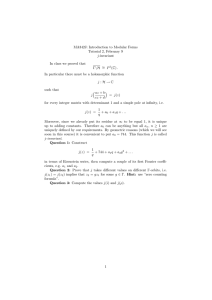16.1 The functional equation
advertisement
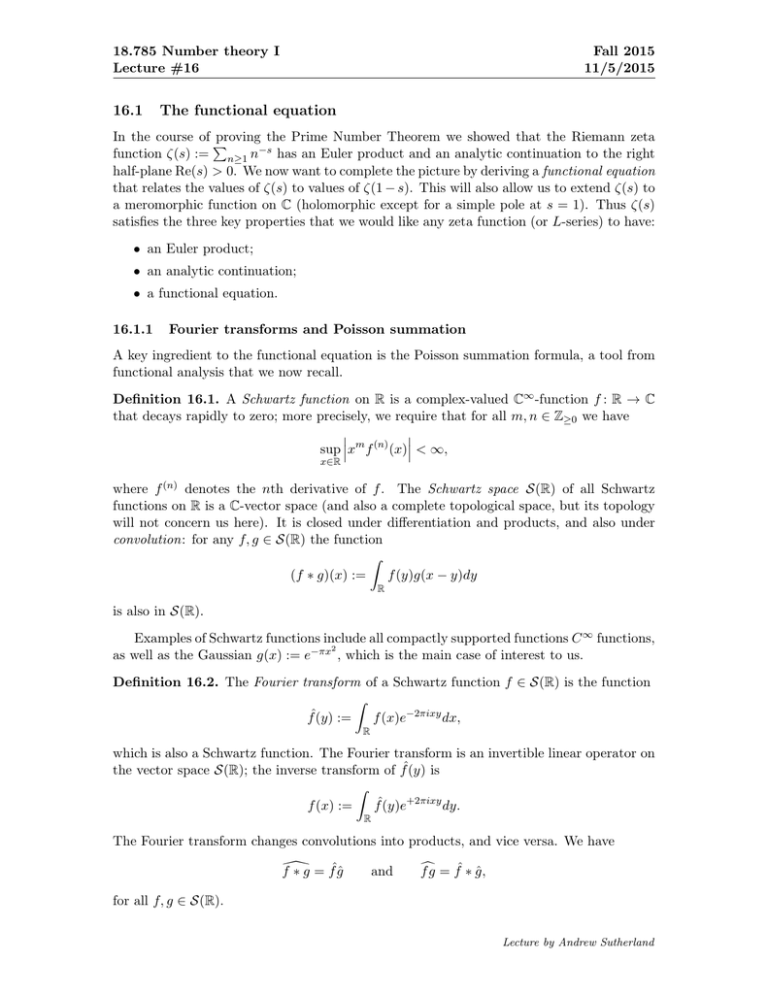
18.785 Number theory I Lecture #16 16.1 Fall 2015 11/5/2015 The functional equation In the course of P proving the Prime Number Theorem we showed that the Riemann zeta function ζ(s) := n≥1 n−s has an Euler product and an analytic continuation to the right half-plane Re(s) > 0. We now want to complete the picture by deriving a functional equation that relates the values of ζ(s) to values of ζ(1 − s). This will also allow us to extend ζ(s) to a meromorphic function on C (holomorphic except for a simple pole at s = 1). Thus ζ(s) satisfies the three key properties that we would like any zeta function (or L-series) to have: • an Euler product; • an analytic continuation; • a functional equation. 16.1.1 Fourier transforms and Poisson summation A key ingredient to the functional equation is the Poisson summation formula, a tool from functional analysis that we now recall. Definition 16.1. A Schwartz function on R is a complex-valued C∞ -function f : R → C that decays rapidly to zero; more precisely, we require that for all m, n ∈ Z≥0 we have sup xm f (n) (x) < ∞, x∈R where f (n) denotes the nth derivative of f . The Schwartz space S(R) of all Schwartz functions on R is a C-vector space (and also a complete topological space, but its topology will not concern us here). It is closed under differentiation and products, and also under convolution: for any f, g ∈ S(R) the function Z (f ∗ g)(x) := f (y)g(x − y)dy R is also in S(R). Examples of Schwartz functions include all compactly supported functions C ∞ functions, 2 as well as the Gaussian g(x) := e−πx , which is the main case of interest to us. Definition 16.2. The Fourier transform of a Schwartz function f ∈ S(R) is the function Z fˆ(y) := f (x)e−2πixy dx, R which is also a Schwartz function. The Fourier transform is an invertible linear operator on the vector space S(R); the inverse transform of fˆ(y) is Z f (x) := fˆ(y)e+2πixy dy. R The Fourier transform changes convolutions into products, and vice versa. We have f[ ∗ g = fˆĝ and fcg = fˆ ∗ ĝ, for all f, g ∈ S(R). Lecture by Andrew Sutherland Theorem 16.3 (Poisson Summation Formula). For all f ∈ S(R) we have the identity X X f (n) = fˆ(n). n∈Z n∈Z Proof. We first note that both sums are well defined; the rapid P decay property of Schwartz functions guarantees absolute convergence. Let F (x) := n∈Z f (x + n). Then F is a periodic C ∞ -function, so it has a Fourier series expansion X F (x) = cn e2πinx , n∈Z with Fourier coefficients Z Z 1 −2πint F (x)e dt = cn = 0 1 X f (x + m)e −2πiny Z dy = 0 m∈Z f (x)e−2πiny dy = fˆ(n). R We then note that X X X X f (n) = lim F (x) = lim fˆ(n)e2πinx = lim fˆ(n)e2πinx = fˆ(n), x→0 n∈Z x→0 n∈Z x→ 0 n∈Z n∈Z where we have used f ∈ S(R) to justify interchanging the limit and sum (alternatively, one can view the limit as a uniformly converging sequence of functions). 2 We now note that the Gaussian function g(x) := e−πx is its own Fourier transform. 2 Lemma 16.4. Let g(x) := e−πx . Then ĝ(y) = g(y). Proof. We have +∞ Z ĝ(y) = 2 e−πx e−2πixy dx = Z =e 2 +2ixy+y 2 −y 2 ) e−π(x dx −∞ −∞ = e−πy +∞ 2 −πy 2 Z +∞ 2 e−π(x+iy) dx = e−πy −∞ +∞ 2 Z +∞+iy 2 e−π(x+iy) dx −∞+iy Z e −πt2 dt = e −πy 2 = g(y). −∞ 2 We used a contour integral of the holomorphic function f (x + iy) = e−π(x+iy) along the rectangular contour −r → r → r + i → −r + i → −r with r → ∞ to shift the integral up by i in the second line: the integral along the vertical sides vanishes as r → ∞, so the contributions form the horizontal sides must be equal and We used the change of R +∞opposite. 2 2 −πt variable t = x + iy to get the third line, and note that −∞ e dx = 1, because e−πt is a probability distribution (or insert your favorite proof of this fact here). √ b a (y) = √ag(y √a). Corollary 16.5. For any a ∈ R× , if Ga (x) := g(x/ a) then G √ Proof. Proceeding as in the first line of the lemma and substituting x → ax yields Z +∞ Z +∞ √ √ 2 2 2 −πx2 /a −2πixy b Ga (y) = e e dx = a e−π(x +2ixy a+y a−y a) dx −∞ −∞ = √ ae −πy 2 a Z +∞ · e−π(x+iy √ a)2 dx = √ √ ag(y a) · 1. −∞ 18.785 Fall 2015, Lecture #16, Page 2 16.1.2 Jacobi’s theta function We now define the theta function 1 Θ(τ ) := X 2 eπin τ . n∈Z The sum is absolutely convergent for Im τ > 0 and thus defines a holomorphic function on the upper half plane. It is easy to see that Θ(τ ) is periodic modulo 2, that is Θ(τ + 2) = Θ(τ ), but it it also satisfies another functional equation. Lemma 16.6. For all y ∈ R>0 we have Θ(i/y) = √ yΘ(iy) Proof. Plugging τ = iy into Θ(τ ) yields Θ(iy) = X 2 e−πn y . n∈Z 2 /y Applying Corollary 16.5 to Gy (n) = e−πn summation (Theorem 16.3) yields Θ(iy) = b y (n) = √ye−πn2 y , and Poisson , we have G X X 1 1 b y (n) = √1 Gy (n) = √ Θ (i/y) . √ G y y y n∈Z n∈Z The lemma follows. 16.1.3 Euler’s gamma function You are probably familiar with the gamma function Γ(s), which plays a key role in the functional equation of not only the Riemann zeta function but many of the more general zeta functions and L-series we wish to consider. Here we recall some of its analytic properties. We begin with the definition of Γ(s) as a Mellin transform. Definition 16.7. The Mellin transform of a function f : R>0 → C is the complex function defined by Z ∞ M(f )(s) := f (t)ts−1 dt, 0 whenever this integral R ∞ converges. It is holomorphic on Re s ∈ (a, b) for any interval (a, b) where the integral 0 |f (t)|tσ−1 dt converges for all σ ∈ (a, b). Definition 16.8. The Gamma function Γ(s) := M(e−t )(s) = Z ∞ e−t ts−1 dt, 0 1 The function Θ(τ ) we define here is a special case of one of four parameterized families of theta functions Θi (z : τ ) originally defined by Jacobi for i = 0, 1, 2, 3, which play an important role in the theory of elliptic functions and modular forms; in terms of Jacobi’s notation, Θ(τ ) = Θ3 (0; τ ). 18.785 Fall 2015, Lecture #16, Page 3 R∞ is the Mellin transform of e−t . Since 0 |e−t |tσ−1 dt converges for all σ > 0, the integral defines a holomorphic function on Re(s) > 0. Integration by parts yields Z ts e−t ∞ 1 ∞ −t s Γ(s + 1) + e t dt = , Γ(s) = s s 0 s 0 R −∞ thus Γ(s) has a simple pole at s = 0 with residue 1 (since Γ(1) = 0 e−t dt = 1), and Γ(s + 1) = sΓ(s) (1) for Re(s) > 0. Equation (1) allows us to extend Γ(s) to a meromorphic function on C with simple poles at s = 0, −1, −2, . . ., and no other poles. An immediate consequence of (1) is that for integers n > 0 we have Γ(n + 1) = nΓ(n) = n(n − 1)Γ(n − 1) = n(n − 1)(n − 2) · · · 2 · 1] · Γ(1) = n!, thus the gamma function can be viewed as an extension of the factorial function. The gamma function satisfies many useful identities in addition to (1), including the following. Theorem 16.9 (Euler’s Reflection Formula). We have Γ(s)Γ(1 − s) = π . sin(πs) as meromorphic functions on C with simple poles at each integer s ∈ Z. Proof. See [1, §6 Thm. 1.4] Example 16.10. Putting s = 1 2 in the reflection formula yields Γ( 12 )2 = π, so Γ( 12 ) = √ π. Corollary 16.11. The function Γ(s) has no zeros on C. Proof. Suppose Γ(s0 ) = 0. The RHS of Euler’s reflection formula is never zero, since sin(πs) has no poles, so Γ(1 − s) must have a pole at s0 . Therefore 1 − s0 ∈ Z≤0 , equivalently, s0 ∈ Z≥1 , but Γ(s) = (s − 1)! 6= 0 for s ∈ Z≥1 . 16.1.4 Completing the zeta function Let us now consider the function F (s) := π −s Γ(s)ζ(2s), which is a meromorphic on C and holomorphic on Re(s) > 1/2. We will restrict our attention P −2s the this region, in which the sum n≥1 n defining ζ(2s) is absolutely convergent. We have X XZ ∞ 2 −s F (s) = (πn ) Γ(s) = (πn2 )−s ts−1 e−t dt, n≥1 n≥1 0 and the substitution t = πn2 y with dt = πn2 dy yields XZ ∞ XZ 2 2 −s 2 s−1 −πn2 y πn dy = F (s) = (πn ) (πn y) e n≥1 0 ∞ 2 y s−1 e−πn y dy. n≥1 0 18.785 Fall 2015, Lecture #16, Page 4 The sum is absolutely convergent, so by the Fubini-Tonelli theorem, we can swap the sum and the integral to obtain Z ∞ X 2 F (s) = y s−1 e−πn y dy. 0 We have Θ(iy) = P n∈Z e −πn2 y =1+2 n≥1 P −πn2 y , n≥1 e thus Z 1 ∞ s−1 y (Θ(iy) − 1)dy 2 0 Z 1 Z ∞ 1 1 s−1 s−1 = y (Θ(iy) − 1)dy y Θ(iy)dy − + s 2 1 0 F (s) = We now focus on the first integral. Making the change of variable t = Z 1 y s− 1 Z 1 Θ(iy)dy = t Θ(i/t)(−t −2 Z )dt = ∞ 0 By Lemma 16.6, Θ(i/t) = 1−s √ ∞ 1 y yields t−s−1 Θ(i/t)dt. 1 R∞ R∞ tΘ(it), and adding − 1 t−s−1/2 dt + 1 t−s−1/2 dt = 0 yields Z ∞ Z ∞ = t−s−1/2 Θ(it)dt − 1 dt + t−s−1/2 dt 1 Z1 ∞ 2 −s−1/2 = t Θ(it)dt − 1 dt − . 1 − 2s 1 Plugging this back into our equation for F (s) we obtain Z 1 1 1 ∞ s−1 y + y −s−1/2 Θ(iy) − 1 dy − − . F (s) = 2 1 2s 1 − 2s We now observe that F (s) = F ( 21 −s), allowing us to extend F (s) to a meromorphic function on C. Replacing s with s/2 leads us to define the completed zeta function Z(s) := π −s/2 Γ(s/2)ζ(s), which is meromorphic on C and satisfies the functional equation Z(1 − s) = Z(s). If has simple poles at 0 and 1 (and no other poles). The only zeros of Z(s) on Re(s) > 0 are the zeros of ζ(s), since by Corollary 16.11, the gamma function Γ(s) has no zeros (and neither does π −s/2 ). Thus the zeros of Z(s) on C all lie in the critical strip 0 < Re(s) < 1. The functional equation also allows us to extend ζ(s) to a meromorphic function on C. It has no poles other than the simple pole at 1, since π −s/2 Γ(s) has no zeros and the simple pole of Z(s) at 0 corresponds to the simple pole of Γ(s/2) at zero. Notice that Γ(s/2) has poles at 0, −2, −4, . . ., so our extended ζ(s) must have zeros at −2, −4, . . . (but not at 0). These are the trivial zeros of ζ(s); all the interesting zeros lie in the critical strip (and under the Riemann hypothesis, on the critical line Re(s) = 1/2, the axis of symmetry in the functional equation). 18.785 Fall 2015, Lecture #16, Page 5 We can determine the value of ζ(0) via the functional equation. We know that ζ(s) has a pole of residue 1 at s = 1, thus 1−s (s − 1)π − 2 Γ( 1−s 2 )ζ(1 − s) 1 = lim (s − 1)ζ(s) = lim . −s/2 s→1+ s→1+ π Γ( 2s ) In the limit the denominator on the RHS is 1, since Γ(1/2) = π 1/2 , and in the numerator we have π (s−1)/2 = 1. Using Γ(z) = z1 Γ(z + 1) to shift the gamma factor in the numerator, 2 1 = lim (s − 1) 1−s Γ 3−s ζ(0) = −2Γ(1)ζ(0) = −2ζ(0), 2 s→1+ thus ζ(0) = −1/2. If we write out the Euler product for the completed zeta function, we have Y Z(s) = π −s/2 Γ(s/2) (1 − p−s )−1 . p One should think of this as a product over the places of the field Q; the leading factor ΓR := π −2/s Γ(s/2) that distinguishes the completed zeta function Z(s) from ζ(s) corresponds to the real archimedean place of Q. When we discuss Dedekind zeta functions in a later lecture we will see that there are gamma factors ΓR and ΓC associated to each of the real and complex archimedean places. If we incorporate an additional factor of 21 s(s − 1) in Z(s) we can remove the poles at 0 and 1, yielding an entire function ξ(s). Theorem 16.12 (Analytic Continuation II). The function ξ(s) := 12 s(s − 1)π −s/2 Γ(s/2)ζ(s) is holomorphic on C and satisfies the functional equation ξ(1 − s) = ξ(s). The zeros of ξ(s) all lie in the critical strip 0 < Re(s) < 1. Remark 16.13. It is usually more convenient to just work with Z(s) and deal with the poles rather than making it holomorphic by introducing additional factors; some authors use ξ(s) to denote our Z(s). References [1] Elias M. Stein and Rami Shakarchi, Complex analysis, Princeton University Press, 2003. 18.785 Fall 2015, Lecture #16, Page 6 MIT OpenCourseWare http://ocw.mit.edu 18.785 Number Theory I Fall 2015 For information about citing these materials or our Terms of Use, visit: http://ocw.mit.edu/terms.
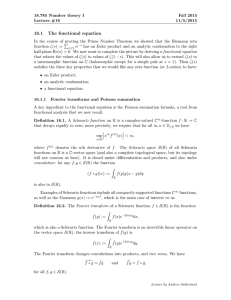
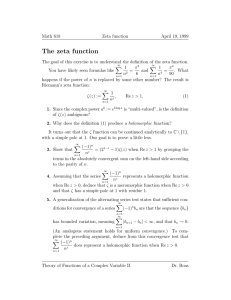
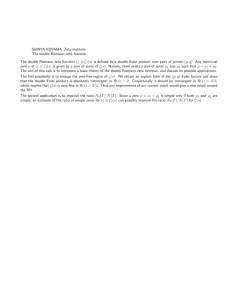


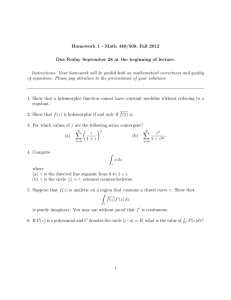
![Mathematics 414 2003–04 Exercises 5 [Due Monday February 16th, 2004.]](http://s2.studylib.net/store/data/010415766_1-b65af2bb66ab8e422354912dcedcb6a6-300x300.png)

